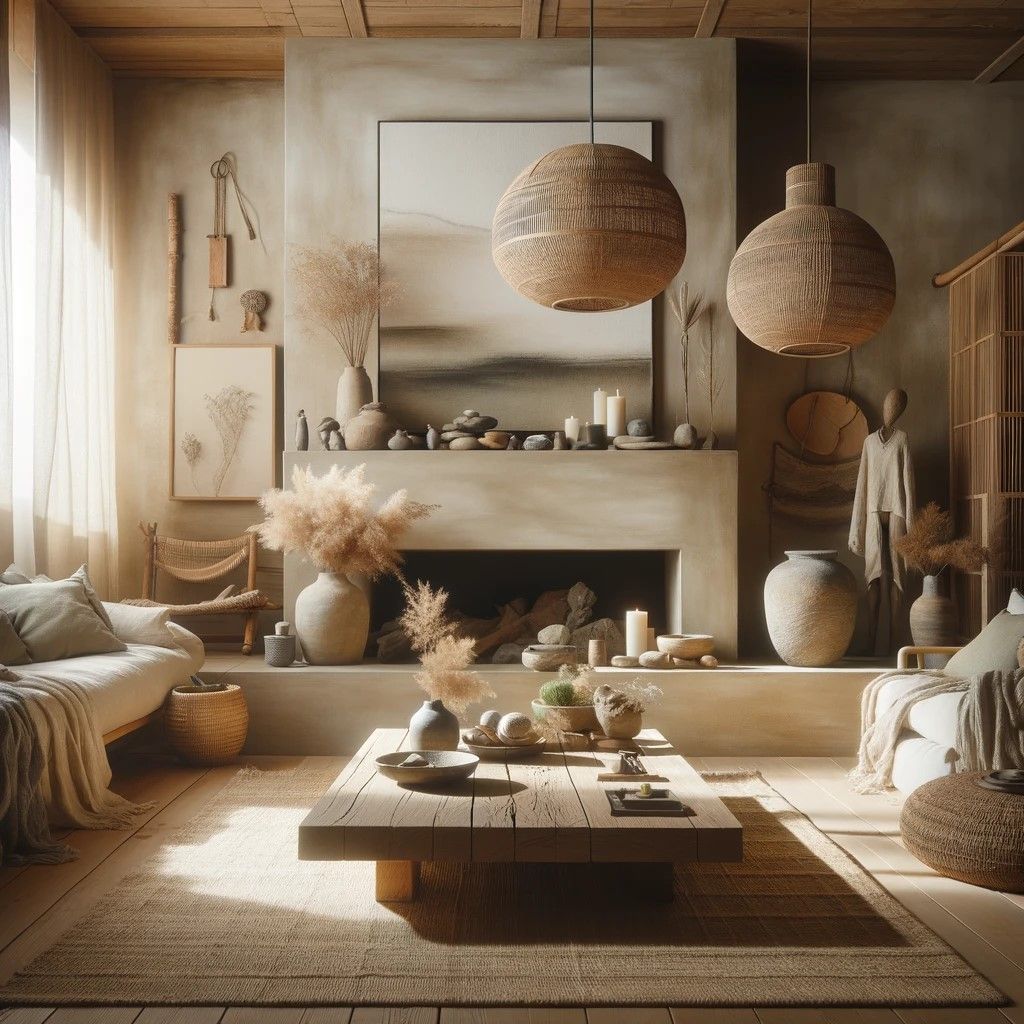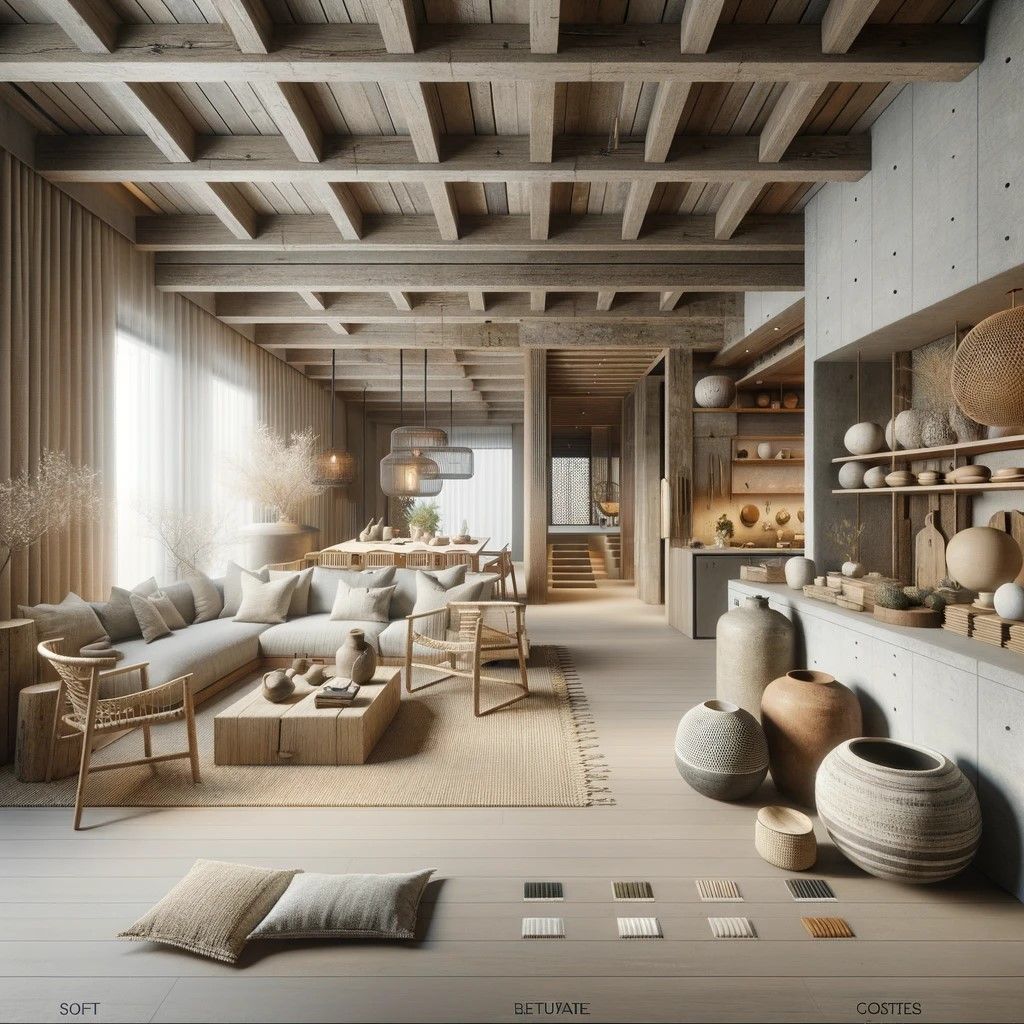By Adam Pencraft, 20th March 2024
Introduction: A New Perspective on Beauty
Singapore's fast-paced, modern landscape is the perfect backdrop for the introduction of Wabi-Sabi, an ancient Japanese philosophy that embraces the beauty of imperfection, impermanence, and simplicity. This design trend is gaining traction among homeowners seeking solace and authenticity in their living spaces. With similarities to minimalist and Scandinavian designs, let's look into what makes Wabi-Sabi different from the rest.
The Essence of Wabi-Sabi
Wabi-Sabi represents a departure from the relentless pursuit of perfection, encouraging a heartfelt appreciation for the aged, the imperfect, and the modest. It's about finding beauty in the "flaws" of life and design.
Wabi-Sabi and Singaporean Culture
In a society that often values newness and precision, Wabi-Sabi offers a refreshing counterpoint. It aligns with Singapore's rich tapestry of cultures and histories, providing a design philosophy that resonates with depth and authenticity.
The Materials of Wabi-Sabi
Natural Textures and Elements
Wabi-Sabi interior design leans heavily on materials that age gracefully and tell a story. Think natural wood with visible grain, stone, bamboo, and even raw concrete walls — each adding a unique texture and warmth to the home.
Crafting With Imperfection
Handmade objects, with their inherent irregularities, are prized for their ability to bring character and uniqueness into a space. These items, be they pottery, textiles, or furniture, embody the Wabi-Sabi spirit.
The Colors of Wabi-Sabi
Earthy Tones for Serenity
A Wabi-Sabi color palette draws from nature, favoring muted, subdued shades of greens, browns, and grays. These colors create a calming, grounding atmosphere in any room.
Lighting: The Natural Glow
Soft, natural lighting is pivotal in Wabi-Sabi design, enhancing the interplay of light and shadow and emphasizing the textures and nuances of the materials used.
Creating Wabi-Sabi Spaces

The Living Room: A Place of Harmony
The heart of the home, the living room, can embody Wabi-Sabi principles through minimalistic furniture arrangements, a focus on natural elements, and a dedication to creating a space that feels genuinely welcoming.
The Kitchen: Culinary Simplicity

In the kitchen, Wabi-Sabi manifests in the choice of simple, functional utensils, the celebration of handmade dishes, and surfaces that embrace wear as a sign of life well-lived.
Personalizing With Wabi-Sabi
Incorporating Family Heirlooms
Wabi-Sabi encourages the display and use of items that have been passed down through generations, allowing their stories and beauty to enrich the home environment.
Art and Decoration
Selecting art and decorative items that speak to the Wabi-Sabi aesthetic involves choosing pieces that evoke a sense of tranquility and depth, often found in nature-inspired works.
The Wabi-Sabi Bedroom

The bedroom, designed with Wabi-Sabi principles, prioritizes comfort, simplicity, and the use of materials that promote relaxation and a deep sense of peace.
Decorative Simplicity
Minimal decor that emphasizes quality and authenticity over quantity helps create a restful and rejuvenating space, true to the Wabi-Sabi way.
The Wabi-Sabi Bathroom
A Retreat for Reflection
Wabi-Sabi in the bathroom focuses on creating a spa-like atmosphere with the use of natural materials, simple lines, and a connection to nature through elements like plants or stones.
Functionality Meets Beauty
Every item in a Wabi-Sabi bathroom has a purpose, from the towels to the bath mats, each chosen for its ability to blend functionality with aesthetic appeal.
Outdoor Spaces and Wabi-Sabi
Gardens: Wild and Whimsical
Wabi-Sabi gardens are imperfectly perfect, with native plants, natural pathways, and unstructured designs that invite wildlife and create a sense of serenity and connection to the earth.
Balconies and Patios
Even in smaller outdoor spaces like balconies, the Wabi-Sabi approach can transform them into tranquil retreats using potted plants, natural materials, and simple, cozy furnishings.
Living the Wabi-Sabi Lifestyle

Mindfulness and Appreciation
Adopting a Wabi-Sabi lifestyle means cultivating mindfulness and an appreciation for the beauty in the everyday and the impermanent.
Simplifying Life
It also means decluttering not just our physical spaces but our lives, focusing on what truly matters and finding joy and contentment in simplicity.
The Wabi-Sabi Dining Experience
Meals with Meaning
The dining table, set with handmade dishes and surrounded by chairs that bear the marks of time, becomes a place for meaningful gatherings, where the focus is on the company and the conversation, not the perfection of the setting.
The Role of Imperfect Beauty
Every chip in a plate, every uneven napkin fold becomes part of the beauty of a meal shared in a Wabi-Sabi home, celebrating the imperfection as a part of life.
Wabi-Sabi for the Singaporean Soul
A Reflection of Values
In Singapore, where tradition and innovation often intersect, Wabi-Sabi offers a way to honor cultural heritage while embracing a forward-thinking approach to living and design.
The Future of Interior Design
As more Singaporeans seek authenticity and meaning in their homes and lives, Wabi-Sabi's principles of embracing natural beauty, simplicity, and the inherent imperfection of life are likely to influence future trends in interior design.
Embracing Imperfection
In our pursuit of a harmonious home, Wabi-Sabi offers profound lessons in beauty and simplicity. By embracing the imperfect, the transient, and the modest, we open our homes and hearts to a deeper, more authentic way of living. As Singapore continues to evolve, the timeless wisdom of Wabi-Sabi reminds us to appreciate the beauty that lies in the natural cycle of life and the imperfect moments that make our lives uniquely beautiful.
Intrigued by the serene beauty of Wabi-Sabi interior design? Contact us to connect with skilled interior designers who specialize in bringing this peaceful aesthetic to life in Singaporean homes. Find more articles and design wisdom on our website, where inspiration meets practical advice for your living spaces.
Join our engaging community on Instagram and Facebook for a regular stream of inspiration and practical design tips tailored just for you.
FAQ: Understanding Wabi-Sabi Interior Design
What is Wabi-Sabi Interior Design?
Wabi-Sabi interior design is a philosophy rooted in ancient Japanese tradition that finds beauty in imperfection, simplicity, and the natural aging process. It emphasizes authenticity, the use of natural materials, and a connection to the natural world.
What Are the Elements of Wabi-Sabi Interior Design?
Key elements include natural materials (wood, stone, bamboo), earthy colors, handmade objects, simplicity, and items that embrace imperfection and show signs of wear or age gracefully.
What Are the Characteristics of Wabi-Sabi Style?
Characteristics of Wabi-Sabi style include asymmetry, roughness or irregularity, simplicity, modesty, intimacy, and the appreciation of the ingenuous integrity of natural objects and processes.
Who Are the Famous Interior Designers Who Use Wabi-Sabi?
Famous designers who incorporate Wabi-Sabi principles into their work include Axel Vervoordt, John Pawson, and Tadao Ando, known for their minimalist designs that highlight natural beauty and imperfection.
How to Create a Wabi-Sabi Home?
Creating a Wabi-Sabi home involves incorporating natural materials, selecting furniture and decor that are simple yet beautiful in their wear, embracing natural light, and allowing spaces to be imperfect and lived-in.
What Are the Colors for Wabi-Sabi Style?
Wabi-Sabi colors are typically muted and drawn from nature, including shades of beige, brown, gray, white, and soft greens and blues.
What Is Wabi-Sabi Decor Style?
Wabi-Sabi decor style focuses on minimalist arrangements, the beauty of natural materials, and decorations that highlight simplicity and the beauty of imperfection.
What Is Wabi-Sabi Design Style?
Wabi-Sabi design style is an approach to interior design that emphasizes minimalism, the use of textured and natural materials, and a serene, understated aesthetic that celebrates imperfection.
What Are the Three Principles of Wabi-Sabi?
The three core principles are impermanence (nothing lasts), imperfection (nothing is perfect), and incompleteness (nothing is finished).
What Is the Wabi-Sabi Style Similar To?
Wabi-Sabi is often compared to minimalist design but is distinct in its emphasis on warmth, natural materials, and the beauty of imperfection. It shares similarities with Scandinavian design in its simplicity and functionality.
What Is the Concept of Wabi-Sabi?
The concept of Wabi-Sabi is a worldview rooted in Zen Buddhism that appreciates the beauty found in the natural cycle of growth and decay. It celebrates the flawed, the irregular, and the modest.
How Do I Apply Wabi-Sabi in Real Life?
Applying Wabi-Sabi in real life involves adopting a mindset that values simplicity, finds beauty in aging and imperfection, and appreciates the inherent worth of natural objects and processes.
What Is Wabi-Sabi Minimalism?
Wabi-Sabi minimalism is a blend of Wabi-Sabi's appreciation for imperfection and minimalism's focus on simplicity. It emphasizes decluttered spaces but with a warm, natural aesthetic that values the history and character of objects.
What Is the Difference Between Wabi-Sabi and Minimalism?
While both Wabi-Sabi and minimalism appreciate simplicity, Wabi-Sabi focuses more on the beauty of natural imperfections and aging, whereas minimalism emphasizes clean lines, order, and a lack of clutter.
What Is the Difference Between Wabi-Sabi and Japandi?
Japandi is a design trend that combines the modern, minimalist lines of Scandinavian design with the traditional Wabi-Sabi appreciation for natural materials and textures. While both prioritize simplicity and natural elements, Japandi tends to be more structured and clean, whereas Wabi-Sabi embraces imperfection and wear.
What Are the Rules of Wabi-Sabi Interior Design?
While Wabi-Sabi is more of a philosophy than a set of strict rules, key principles include appreciating the imperfect and transient nature of objects, focusing on simplicity and authenticity, and valuing the stories behind handmade and aged items.





